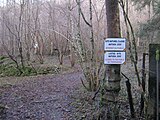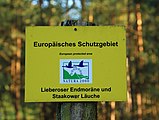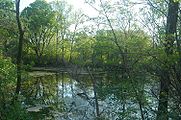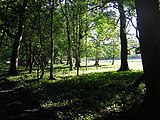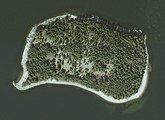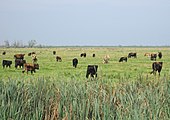Natura 2000
 | |
 Natural protected area of Els Ports | |
| Founded | 1992 |
|---|---|
| Type | Network ofnature protection areas |
Area served | European Union |
| Website | ec |
Natura 2000is a network ofnature protection areasin the territory of theEuropean Union.It is made up ofSpecial Areas of ConservationandSpecial Protection Areasdesignated under theHabitats Directiveand theBirds Directive,respectively. The network includes both terrestrial andMarine Protected Areas.
The Natura 2000 network covered more than 18% of the European Union's land area and more than 7% of its marine area in 2022.[1]
History
[edit]In May 1992, the governments of theEuropean Communitiesadopted legislation designed to protect the most seriously threatenedhabitatsandspeciesacross Europe. TheHabitats Directivecomplements theBirds Directiveadopted in 1979, and together they make up the Natura 2000 network of protected areas.
The Birds Directive requires the establishment ofSpecial Protection Areasfor birds. The Habitats Directive similarly requiresSites of Community Importancewhich upon the agreement of the European Commission becomeSpecial Areas of Conservationto be designated for species other than birds, and for habitat types (e.g. particular types of forest, grasslands, wetlands, etc.). Together, Special Protection Areas and Special Areas of Conservation form the Natura 2000 network of protected areas.
The Natura 2000 network is the EU contribution to the "Emerald network"of Areas of Special Conservation Interest set up under theBern Convention on the conservation of European wildlife and natural habitats.Natura 2000 is also a key contribution to the Program of Work of Protected Areas of theConvention on Biological Diversity.
As a prerequisite for joining the EU, accession states have to submit proposals for Natura 2000 sites meeting the same criteria as EU member states. Some new member states have large areas which qualify to be protected under the directives, and implementation has not always been simple.[2]
The Natura 2000 sites are selected by member states and the European Commission following strictly scientific criteria according to the two directives mentioned above. The Special Protection Areas are designated directly by eachEU member state,while the Special Areas of Conservation follow a more elaborate process: each EU member state must compile a list of the best wildlife areas containing the habitats and species listed in the Habitats Directive; this list must then be submitted to theEuropean Commission,after which an evaluation and selection process on European level will take place in order to become a Natura 2000 site.
The Habitats Directive divides the EU territory intonine biogeographic regions,[3]each with its own ecological coherence. Natura 2000 sites are selected according to the conditions in each biogeographical region; thus selected sites represent species and habitat types under similar natural conditions across a suite of countries.
Each Natura 2000 site has a unique identification form called a standard data form. This form is used as a legal reference when assessing the management of the species and habitats through the concept of favourable conservation status. The Natura 2000 Viewer[4]is a tool to explore the network and gives access to every standard data form.
Current status
[edit]As of 2017[update],Natura 2000 protected 27,312 sites with a terrestrial area of 787,606 km2(304,096 sq mi) (around 18 percent of land of the EU countries) and marine area of 360,350 km2(139,130 sq mi),[5]and was considered almost complete in the EU terrestrial environment. The process of designation has not always been smooth as the infringement procedures against member states show.[6]While designation of sites may be near complete, the management and enforcement of protection on sites is less advanced and many sites lack management plans.[7]Natura 2000 faced criticism from developers, farmers and politicians who fear that the conservation of habitats and species places a brake on development.[8]
In 2013, there were 251,564 km2(97,129 sq mi) designated as Natura 2000 in the marine environment. The network in marine areas is not considered complete and acknowledged by the Commission as a "key challenge for EUbiodiversitypolicy in the coming years ".[9]
Natura 2000 sites can vary considerably in character. They are not strictly protected in terms of how they are allowed to be used by people. Many sites are farmed, forested and some are even in urban areas. Other areas are much wilder. TheEuropean Commissiondeveloped guidelines on the relation between Natura 2000 and wild areas which are thought to make up around 13% of the network.[10]This was in response to a report byMembers of the European Parliamentin 2009 which called for further protection of Europe's wilderness.[11]
-
Sign identifying a "Natura 2000 area" (Haslauer Moornature reserve) inAustria
-
Sign identifying a Natura 2000 site inBelgium.
-
Sign identifying a "European protected area" (Special Area of ConservationLieberoser Endmoräne und Staakower Läuche) inGermany
-
TheFoloi oak forestinGreeceis a Natura 2000 site.
-
Castro Verde,Natura 2000 site inPortugal
-
Natura 2000 locality inSlovakia
-
TheOostvaardersplassenis a Natura 2000 site in theNetherlands.
Raising awareness
[edit]The Natura 2000 network is not well known among European Union citizens; only 11% of citizens knew what it was in 2013.[12]As part of theEU Biodiversity Strategy,the European Commission committed to raise awareness about the network and biodiversity in general with the public.
Natura 2000 Day
[edit]In order to raise awareness about the Natura 2000 network, 21 May has been designated “Natura 2000 Day”. This precedes “International Day for Biological Diversity” on 22 May. The initiative came fromSEO/BirdLifewho sought and received funding from the EULIFE+programme in order to improve the knowledge of this network.[13]
In 2013, the first Natura 2000 day took place with the aim to raise awareness of citizens about the importance of Natura 2000 network in their lives. Since then, every May 21 and the weeks before, awareness actions take place all over Europe. For example, in 2014, school children and politicians across the EU were encouraged to make a butterfly gesture and post photos on social media to raise awareness.[14]
The Natura 2000 Award
[edit]The Natura 2000 Award[15]was launched by the European Commission in 2013, with the first prizes awarded on Natura 2000 Day in 2014. The annual Award aims to raise awareness about the Natura 2000 network, showcase excellence and encourage networking between people working on Natura 2000 sites.
It awards prizes to those working on the management of or to raise awareness about Natura 2000 in five award categories: Conservation; Socio-Economic Benefits; Communication; Reconciling Interests and Perceptions; Cross-Border Cooperation and Networking. In its first year, winners were selected from Bulgaria, Romania, Czech Republic, Belgium and Spain.
Controversy
[edit]The Natura 2000 legislation, notably with its habitats-test (or: habitats assessment, Article 6 of the Habitats Directive), dates back to the days climate change was not an issue and the concept ofecosystem serviceshad not been well developed. Hence, in international law literature Kistenkas raised the question the habitats assessment was originally not designed for striking a balance of all relevant ecosystem services or to involve climate change into the assessment.[16]Although well protecting nature conservation objectives, a rethinking of the habitats assessment might be necessary in the light of a new climate law as part of e.g. theEuropean Green Deal.[17]
In European law literature Borgstrom and Kistenkas have discussed some possible future incompatibilities of the Natura 2000 habitats-test with novel EUgreen infrastructurepolicies.[18]
In the late 2010s the habitats assessment was at the basis of thenitrogen crisis in the Netherlandsas the EU Court (C-293/17 and C-294/17, ECLI:EU:C:2018:882) ruled on agriculture nearby Natura 2000 sites.[19]
In some other member states, such asBulgaria,there was criticism a project had not been well communicated in advance. This led to construction in theKaliakrazone of Bulgaria, includingwind turbinesand a golf course. Land owners have then been told they may not use their land in certain ways, otherwise non-compliance procedures would be used against Bulgaria. This led to protests by the land-owners.[20]
See also
[edit]- Ecological network
- Forêts et étangs du Perche
- Raspaillebos
- Dieleghem Wood
- Laerbeek Wood
- Agri-environmental measures
References
[edit]- ^JUSSIANT, Evelyne."EC Library Guides: Biodiversity and nature protection: Natura 2000 network".ec-europa-eu.libguides.Retrieved2023-09-21.
- ^Abran, Peter (January 2012)."Gospodărirea pădurilor în siturile Nature 2000 din România - probleme prezente și perspective"[Forest management in the Natura 2000 ecological network in Romania – present problems and perspectives](PDF).Revista pădurilor(in Romanian).127(1): 21–27.ISSN1583-7890.16782.Archived(PDF)from the original on 2020-07-15.Retrieved9 August2023.(abstract in English on p. 27.)
- ^"The Natura 2000 Biogeographical Regions".European Commission Directorate-General for Environment. 29 May 2015.Retrieved9 August2023.
- ^Natura 2000 network viewerlast retrieved 31-10-14
- ^Natura 2000 Barometerlast retrieved 14 July 2017.
- ^DG Environment(31 March 2022).Annual Activity Report 2021(PDF)(Report). Directorate-General for Environment of the European Commission. p. 11.Archived(PDF)from the original on 29 April 2023.Retrieved11 August2023.
Action was taken against 9 Member States to ensure the completion of the Natura 2000 network and the adequate conservation of the Special Areas of Conservation, and was pursued against 5 Member States to address the insufficient protection of species and habitats in decline due to infrastructure projects, agricultural practices or illegal logging.
- ^"On the Road to Recovery?"(PDF).BirdLife International. Archived fromthe original(PDF)on 14 November 2020.Retrieved7 May2017.
- ^Beunen, Raoul; Van Assche, Kristof; Duineveld, Martijn (2013). "Performing failure in conservation policy: The implementation of European Union directives in the Netherlands".Land Use Policy.31:280–288.Bibcode:2013LUPol..31..280B.doi:10.1016/j.landusepol.2012.07.009.
- ^European Commission Natura 2000 in the marine environmentlast retrieved 31-10-14
- ^European Commission Wilderness in Europelast retrieved 31-10-14
- ^MEPs Respond to Call to Protect Europelast retrieved 04-02-09
- ^"Attitudes towards Biodiversity. Flash Eurobarometer 379"(PDF).Archived(PDF)from the original on 2014-04-29.Retrieved7 May2017.
- ^"Project Life Activates your true wealth".Archived fromthe originalon 4 December 2016.Retrieved7 May2017.
- ^"Natura 2000 Day".natura2000day.eu.Retrieved7 May2017.
- ^"European Natura 2000 Award - European Commission".ec.europa.eu.Retrieved7 May2017.
- ^Frederik Hendrik Kistenkas,Innovating European nature conservation law by introducing ecosystem services,GAiA 23/2 (2014): 88-92
- ^Frederik Hendrik Kistenkas,Rethinking European Nature Conservation Legislation: Towards Sustainable Development,Journal for European Environmental & Planning Law (JEEPL) 2013 10/1 72-84,https://brill /view/journals/jeep/10/1/article-p72_6.xml?lang=en,DOI:https://doi.org/10.1163/18760104-01001005(subscription required)
- ^Kistenkas, Frederik H.; Borgström, Suvi (2014)."The Compatibility of the Habitats Directive with the Novel EU Green Infrastructure Policy".European Energy and Environmental Law Review.23(2): 36–44.doi:10.54648/eelr2014004.
- ^Frederik H. Kistenkas, Harm C. Borgers, Machteld E.A. Kistenkas,Recht voor de groene ruimte,3rd ed., Wageningen Academic Publishers 2017
- ^"The Kaliakra protests: The Bulgarian People vs. The EU".Archived fromthe originalon 2018-10-22.Retrieved2017-08-11.
Documentation
[edit]- Natura 2000: Protecting Europe’s biodiversity, published on 2008/11/11, in English digital bookor in paper book (ISBN978-92-79-08308-2).
External links
[edit]- Official website
- Natura 2000 Viewer - interactive map (European Environment Agency)
- Natura 2000 data download – the European network of protected sites (European Environment Agency)
- Natura 2000 newsletter (English, French, German, Spanish, Italian)
- Natura 2000 Award
- Natura 2000 Award Scheme - Environmental Benchmarking Report, 2015
- European Topic Centre on Biological Diversity
- Natura Network Initiative – Natura 2000 at work
- A–Z Areas of Biodiversity Importance: Natura 2000
- Natura 2000 and Marine Environment
- List of webpages Natura 2000 of member states of the European Union
Germany
Latvia
Natura 2000 in the global context


